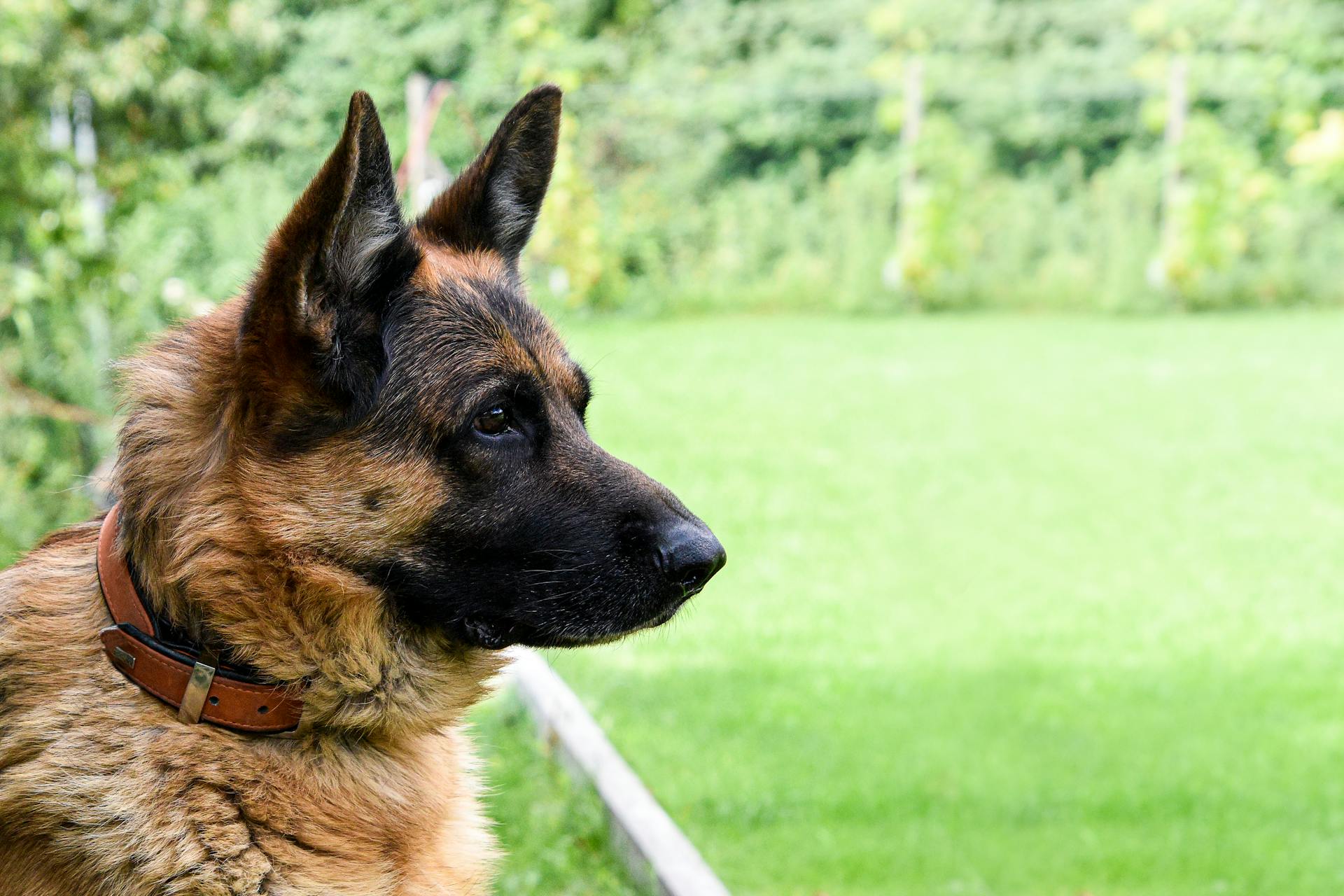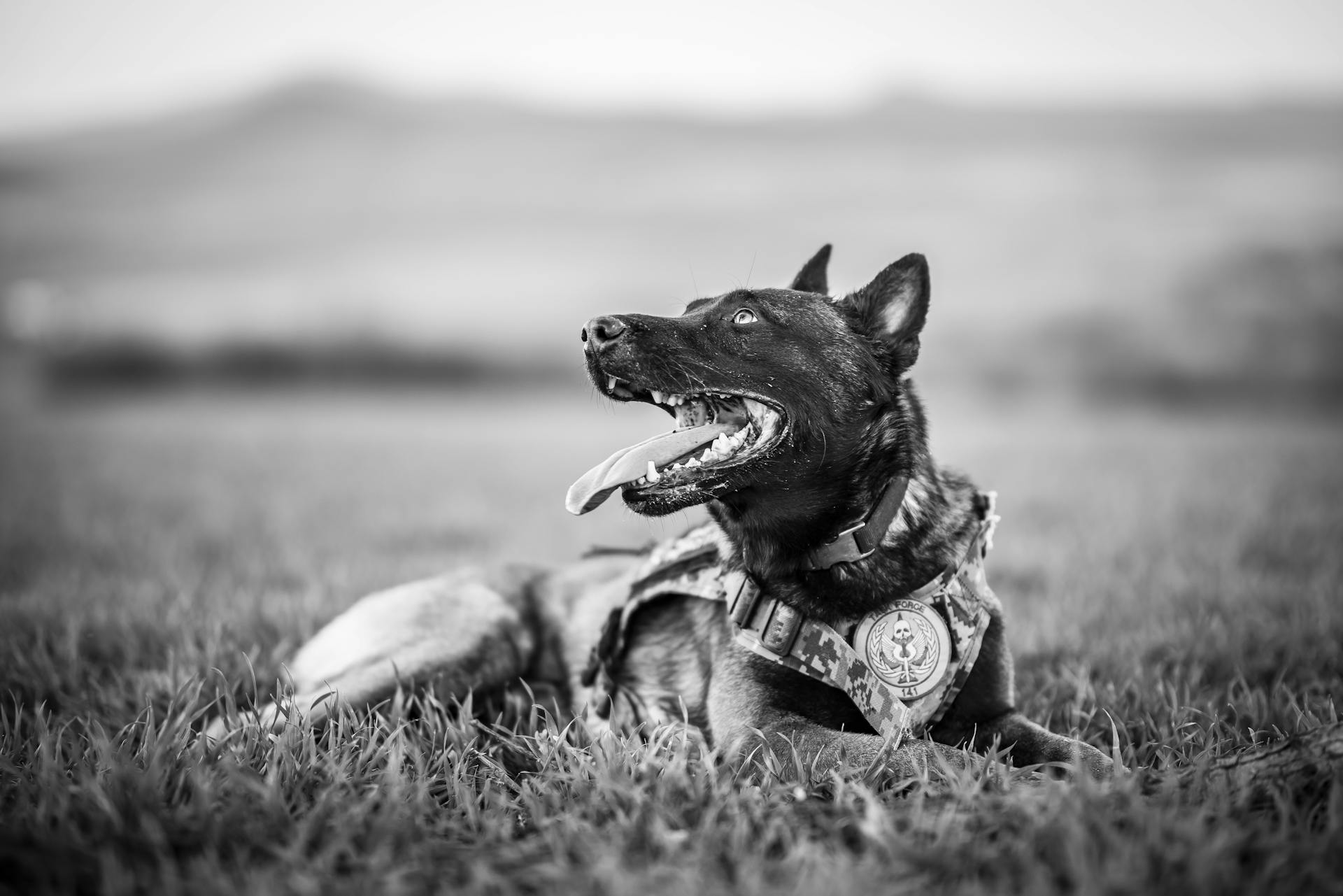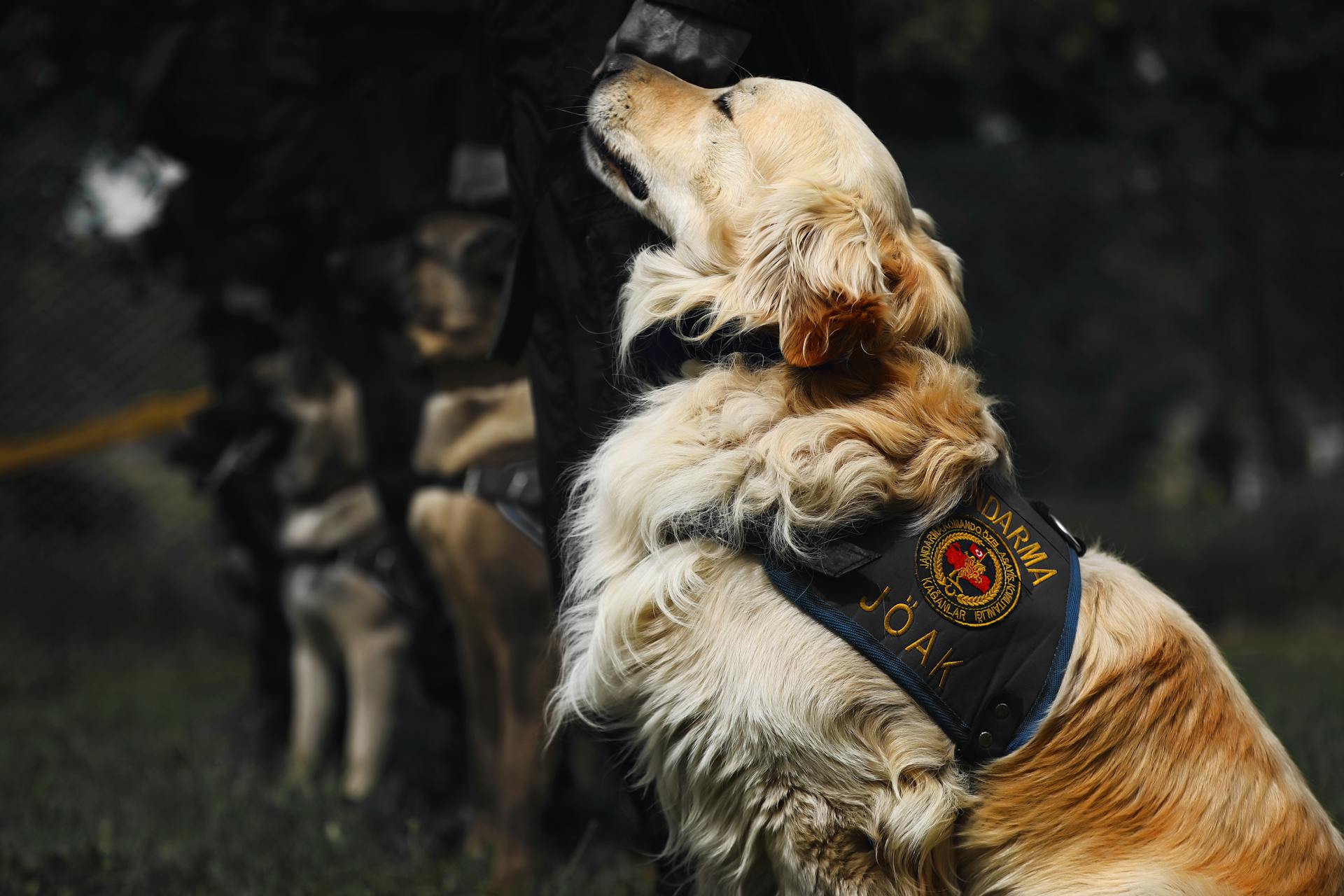
Police K9 units have a rich history that dates back to World War I, where they were first used for sentry duty and messenger work.
Their early success led to the development of specialized breeds for specific tasks, such as the German Shepherd, which became a popular choice for police work due to its intelligence and trainability.
In the 1960s, police K9 units began to focus on narcotics detection, with dogs trained to sniff out heroin and other illicit substances.
For your interest: Dog Work
Early History of Police Dogs
The early history of police dogs is a fascinating topic. Dogs have been used in law enforcement since the Middle Ages.
In the 14th century, dogs were used to guard docks and piers in St. Malo, France. The first recorded use of police dogs was in this region.
The term "Sleuth" originated from the use of bloodhounds in Scotland, known as "Slough dogs". This term is still used today to refer to a detective.
A different take: What Are Service Dogs Used for
Between the 12th and 20th centuries, police dogs on the British Isles and European continent were primarily used for their tracking abilities. This was a crucial aspect of law enforcement during this time.
In the 19th century, urbanization led to increased public concern regarding lawlessness in England and France. Night watchmen were employed to guard premises, and were provided with firearms and dogs to protect themselves from criminals.
One of the first attempts to use dogs in policing was made by Commissioner Sir Charles Warren in 1889. He had two bloodhounds trained for tracking, but the results were far from satisfactory.
Police Dog Breeds
German Shepherds are renowned for their exceptional intelligence, high trainability, and poised disposition, making them a popular choice for police work.
Their strong work ethic and ability to excel in various roles, such as smelling contraband and locating natural disaster victims, have made them a staple in law enforcement.
Suggestion: Police Working Dogs
Dutch Shepherds are among the smartest and most alert K-9 dog breeds, with a strong work ethic that helps them excel in search and rescue and detection work.
Belgian Malinois are known for their natural athletic abilities and top-notch sense of smell, thriving in jobs ranging from sniffing out explosives to apprehending criminals.
Bloodhounds have a powerful sense of smell, so sensitive that it's been used as evidence in some U.S. courts, making them valuable for tracking down missing individuals.
Labrador Retrievers are a top choice for K-9 assignments due to their protective mindsets and peaceful nature, which helps keep the public from feeling afraid when they're walking through policed areas.
Doberman Pinschers are strong and agile, originally bred to be watch dogs, and are now trained to catch fleeing criminals with their high discipline and courage.
American Pit Bull Terriers are emerging as a cost-effective option for police departments, coming from rescues and offering the same key abilities as other breeds, helping to negate their reputation as aggressive and dangerous pets.
German Shepherds, Belgian Malinois, and Labrador Retrievers are commonly used as search and rescue dogs to help law enforcement locate suspects or find missing people.
Curious to learn more? Check out: Are Belgian Malinois Good Guard Dogs
Training and Specialization
Police dogs can be specialized to perform in specific areas, such as apprehension and attack, detection, or search and rescue. Each type of dog has its own unique skills and training.
Apprehension and attack dogs are trained to locate, apprehend, and sometimes subdue suspects. Detection dogs are trained to detect explosives or drugs, while search and rescue dogs are used to locate suspects or find missing people or objects.
Some police dogs are trained to perform multiple tasks, known as dual purpose dogs. These dogs are trained and skilled in tracking, handler protection, off-leash obedience, criminal apprehension, and article, area, and building search.
Here are some examples of police dogs and their specializations:
- Apprehension and attack dogs
- Detection dogs (explosives, drugs, firearms, and ammunition)
- Dual purpose dogs (tracking, handler protection, off-leash obedience, etc.)
- Search and rescue dogs (locating suspects or finding missing people or objects)
Modern Era
In the modern era, police departments in Continental Europe led the way in using dogs for law enforcement. The police department in Ghent, Belgium, introduced the first organized police dog service program in 1899.
Police in Paris used dogs to combat roaming criminal gangs, and their methods soon spread to Austria-Hungary and Germany. The German police selected the German Shepherd Dog as the ideal breed for police work.
Additional reading: German Shepherd Security Dogs
The German police opened up the first dog training school in 1920 in Greenheide, where they systematically trained dogs in obedience to their officers and tracking and attacking criminals. Many Belgian Malinois dogs were added to the unit over the years.
In Britain, the North Eastern Railway Police were among the first to use police dogs in 1908 to stop theft from the docks in Hull. By 1910, railway police forces were experimenting with other breeds, including Belgian Malinois, Labrador Retrievers, and German Shepherds.
Consider reading: Police Dogs Malinois
Specialization
Police dogs can be specialized to perform in specific areas. There are several types of police dogs, each trained for different tasks.
Apprehension and attack dogs are used to locate, apprehend, and sometimes subdue suspects. These dogs are trained to respond to their handler's commands and take down suspects without hesitation.
Detection dogs are trained to detect specific substances, such as explosives or narcotics. Some detection dogs are trained to detect firearms and ammunition.
Consider reading: Detection Dog

Dual purpose dogs, also known as patrol dogs, are trained in multiple skills, including tracking, handler protection, off-leash obedience, criminal apprehension, and area search. These dogs are highly versatile and can perform a variety of tasks.
Search and rescue dogs (SAR) are used to locate missing people or objects. They can be trained to track scents and navigate challenging terrain.
Here are some examples of police dog breeds used for different tasks:
These breeds are commonly used for police work due to their intelligence, athleticism, and strong work ethic. However, other breeds, such as Akitas and Boxers, are also used for specific tasks.
Police dogs are trained to respond to their handler's commands and work in a variety of environments. They are highly valued members of law enforcement teams and play a critical role in keeping communities safe.
A different take: What Is a Work Dog
Working Dogs Are Like Us
Sargent, the police dog, gets along very well with everyone in the house, but when his handler Wyrick isn't there, he is in his crate or kennel.
Sargent's diet consists of Canidae dog food, which he eats 4 to 5 cups daily, depending on the work schedule. He also gets dog treats as rewards.
Sargent's gear includes various leashes, a lowering harness, and occasionally a muzzle. He doesn't wear a bulletproof vest, as the units have found them to be heavy, hot, and restrictive.
Sargent's job requires regular monitoring of his weight, just like an athlete, to ensure he's ready for work and any potential task. He also uses flea/tick medicine like any other dog.
I groom Sargent myself, giving him baths every month and inspecting him daily to ensure no health issues arise.
Accusations of Brutality and Bias
Accusations of brutality and bias surround the use of police dogs in the US.
A 2020 investigation found evidence of widespread deployment of police dogs as disproportionate force against people of color.
The rate of police K-9 bites in Baton Rouge, Louisiana, averages more than double that of the next-ranked city, Indianapolis.
Many people bitten by police dogs were not violent and were not suspected of crimes.
Police officers are often shielded from liability, and federal civil rights laws don't typically cover bystanders who are bitten by mistake.
Global's Approach and Other Topics
Global's police K9 training program prioritizes handler protection, teaching dogs to defend their owners at all costs.
The bond between a working dog and its handler is crucial, and a properly trained K9 is absolutely committed to the protection and well-being of its handler.
Global's experience has shown that German Shepherds and Belgian Malinois are often the most successful candidates for police K9 training, responding well to the handler-protection mentality.
These breeds are fiercely loyal and adjust well to the training, making them ideal choices for police work.
If this caught your attention, see: Why Are Police Dogs Called K9
Global's Approach
Global's Approach is built on a foundation of loyalty and protection. Their police K9 training program prioritizes handler protection, where the dog will defend its owner even without a command.
The most immediate goal of a dog trained by Global is to defend its handler in the event of an attack. This reflects the strong bond between a working dog and its handler.
Recommended read: How to Become a Search and Rescue Dog Handler

Police K9s trained by Global are committed to protecting and well-being of their handlers. This loyalty is what sets great working dogs apart from good ones.
Global's program teaches working dogs to guard criminal suspects while being detained, questioned, and searched. This is the most common use of their police K9 training.
Police dogs are trained to assist officers in their daily duties, requiring specific physical and mental attributes. German Shepherds and Belgian Malinois are often the most successful candidates for this training.
These breeds are fiercely loyal and adjust well to the handler-protection mentality.
You might like: Cattle Dogs Working
Other Elements
Global's Approach to training police K9 dogs is tailored to meet the unique needs of each individual dog and handler.
The basic elements of police K9 training are very similar, but every dog requires a customized approach.
Police dogs are trained for a wide variety of working situations, each requiring specific skill sets.
No two job descriptions for police dogs are ever the same, which is why specialized training is often necessary.
If a specific job is required, Global's trainers can create a customized training program to meet that need.
Expand your knowledge: Old Police Dogs
Frequently Asked Questions
Why is K-9 called K-9?
The term "K-9" is derived from the word "CANINE", with "CA" representing "K" and "NINE" representing "9". This phonetic substitution is believed to have originated in 1942 with the creation of the US military's first K-9 Corps.
Why are Belgian Malinois used as police dogs?
Belgian Malinois are used as police dogs due to their high drive, fearlessness, and trainability. Their compact size also makes them ideal for navigating tight spaces during searches.
Are K-9 and German Shepherd the same?
No, K-9 dogs are not always German Shepherds, but often belong to the Belgian Malinois breed. While German Shepherds are commonly used in search and rescue, the Malinois is a popular choice for its high energy and strong work ethic.
How much does a K9 dog cost?
A new K9 and its training can cost between $15,000 to $20,000. This significant investment is a crucial part of equipping law enforcement with a valuable asset.
What is the new breed of police dog?
The Belgian Malinois is a breed of police dog known for its distinctive appearance and high intelligence. This golden-brown breed is a popular choice for police and military service due to its exceptional skills and abilities.
Featured Images: pexels.com


